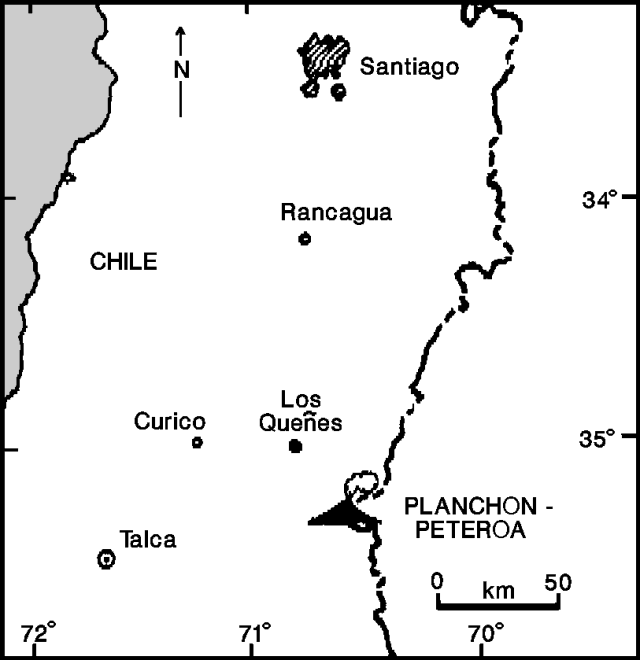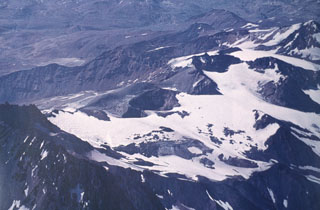Report on Planchon-Peteroa (Chile) — March 2001
Bulletin of the Global Volcanism Network, vol. 26, no. 3 (March 2001)
Managing Editor: Richard Wunderman.
Planchon-Peteroa (Chile) Increased fumarolic activity during January-February 2001
Please cite this report as:
Global Volcanism Program, 2001. Report on Planchon-Peteroa (Chile) (Wunderman, R., ed.). Bulletin of the Global Volcanism Network, 26:3. Smithsonian Institution. https://doi.org/10.5479/si.GVP.BGVN200103-357040
Planchon-Peteroa
Chile
35.223°S, 70.568°W; summit elev. 3977 m
All times are local (unless otherwise noted)
Increased fumarolic activity was reported at Planchón-Peteroa (figure 5) during January and February 2001. There have been no reports of anomalous activity at the volcano since November 1998 when small phreatic eruptions produced explosions that deposited ash up to ~8 km NW of the volcano (BGVN 24:03).
 |
Figure 5. Map showing the location of Planchón-Peteroa (originally in BGVN 16:01). Courtesy of M. Gardeweg, SERNAGEOMIN. |
The first report of possible renewed volcanic activity was made on 12 December 2000 when observers on a commercial flight traveling S past Planchón-Peteroa saw steam rising from a fumarole to heights of 150-200 m and extending ~1 km SSE. The activity was considered normal for the time of year.
Patricia Sruoga of the Servico Geológico Argentino reported that during late January to early February the altitude of steam emitted from fumaroles on Planchón-Peteroa was higher than was observed in 1996 and during trips to the volcano on 3 February and 3 March 1999. She also reported that there was an increase in the frequency of steam emission. The observations were made from Gendarmerie, 6 km E of the volcano. On 6 February observations made from a commercial flight heading S of the volcano revealed that steam from a fumarole rose to a height of ~150 m and extended a little more than 0.5 km toward the E. On 12 February another sighting of steam was made from a commercial aircraft in the area of Curicó (figure 5). Based on the general location, the steam was determined to have originated from one of Planchón-Peteroa's fumaroles.
Information provided by José Piña from the Emergencia de la Municipalidad de Romeral confirmed that during the first couple of weeks of February there was indeed an increase in fumarolic activity. According to an observer in the area, since December 2000 there had been an increase in steam-and-gas emissions from the volcano along with a strong sulphur odor that was especially strong during the night. Piña visited the E flank of the zone of craters and discovered that there was a reddish material on the snow. He determined that the material was deposited through aeolian action, which is common due to strong winds in the area. He also noted that there was intense fumarolic activity at the NE crater, with fumarolic plumes rising up to 300 m above the volcano's W flank. In addition, steam rose up to 100 m high as it escaped from the 1991-92 crater on the E flank. Occasionally there was a strong odor of sulfur and underground noises. Piña also noticed fumaroles on the top of Morro Planchón, whose plumes rose ~3.9 km high. These types of fumaroles were thought to be fed by melted snow that drips through fractures. On 16 February observations from a commercial aircraft traveling towards the N revealed that 500-m-high white fumarolic emissions extended ~1 km towards the SE. GOES imagery of the area in January and February did not show thermal anomalies aside from the normal variations between day and night.
Based on the aforementioned information, the Departamento Geología Aplicada of the Servicio Nacional de Geología y Minería (SERNAGEOMIN) concluded that the increase in fumoralic activity during January and February in comparison to previous years at Planchón-Petero was due to phreatic water produced by the underground infiltration of melted snow. There was an increase in water in the area because there was a greater amount of snow accumulation during 2000 than in previous years. There appeared to be more steam emitted from Planchón-Peteroa's fumaroles than usual due to the reduction in atmospheric temperature at that time of the year and/or the greater ambient humidity causing the water vapor to condense. Although the increase in fumarolic activity was not determined to be of magmatic origin, SERNAGEOMIN noted that the abundance of water could trigger small phreatic explosions that could potentially emit ash and larger pyroclasts. In addition, water that originates from the zone of craters and travels via the Claro River could be contaminated. SERNAGEOMIN recommended that the Claro River should be monitored to determine if contamination occurs and that flights over the volcano should be conducted in order to photograph variations in fumarolic activity. SERNAGEOMIN plans to seismically monitor the E flank of the volcano in order to detect possible microseismicity.
Geological Summary. Planchón-Peteroa is an elongated complex volcano along the Chile-Argentina border with several overlapping calderas. Activity began in the Pleistocene with construction of the basaltic andesite to dacitic Volcán Azufre, followed by formation of the basaltic and basaltic andesite Volcán Planchón, 6 km N. About 11,500 years ago much of Azufre and part of Planchón collapsed, forming the massive Río Teno debris avalanche, which traveled 95 km to reach Chile's Central Valley. Subsequently, Volcán Planchón II was formed. The youngest volcano, andesitic and basaltic andesite Volcán Peteroa, consists of scattered vents between Azufre and Planchón, and and contains a small steaming crater lake. Reported eruptions from the complex have been dominantly explosive, although lava flows were emplaced in 1837 and 1937.
Information Contacts: José Antonio Naranjo, Jefe, Departamento Geología Aplicada, Servicio Nacional de Geología y Minería (SERNAGEOMIN), Avda. Santa Maria 0104, Casilla 1347, Santiago, Chile (URL: http://www.sernageomin.cl/).

